|
Dandapāni
Dandapani was an ancient Indian king from the Koliya dynasty, who ruled a city called Koli. He was born in Devadaha as a Koliya Prince, as one of the sons of Añjana and Yasodharā. He was a brother to Suppabuddha and to his sisters Māyā and Pajāpatī. He was the Buddha's maternal uncle. See also *Shakya * Yasodharā *Devadatta *Suppabuddha Suprabuddha (Sanskrit), or Suppabuddha (Pali) was the maternal uncle and father-in-law of the Buddha according to the Mahavamsa genealogy and the Theravada commentarial tradition. He was also known as Mahāsuppabuddha. Suppabuddha is also t ... References {{DEFAULTSORT:Dandapani Family of Gautama Buddha Koliyas ... [...More Info...] [...Related Items...] OR: [Wikipedia] [Google] [Baidu] |
Suppabuddha
Suprabuddha (Sanskrit), or Suppabuddha (Pali) was the maternal uncle and father-in-law of the Buddha according to the Mahavamsa genealogy and the Theravada commentarial tradition. He was also known as Mahāsuppabuddha. Suppabuddha is also the name of several other individuals mentioned briefly in the Theravada tradition. Sources According to the Mahavamsa, he was the son of king Añjana and his wife Yasodharā. He was the father of both Bhaddakaccānā ( Siddhartha's wife Yasodharā) and Devadatta, the Buddha's rival, from his wife Amitā. He had two sisters, Māyā and Pajāpatī and a brother, Dandapāni. As the mother of Buddha was Maya, that made him the uncle of the Buddha, and as his daughter was the wife of the Buddha, he became also the father-in-law to the Buddha. Western scholars note that the pattern of cross-cousin marriage described in the Mahavamsa genealogy is typical of historical marriage practices in Dravidian societies in Southern India, but not typic ... [...More Info...] [...Related Items...] OR: [Wikipedia] [Google] [Baidu] |
Maya (mother Of Buddha)
Maya (; Devanagari: , IAST: ), also known as Mahāmāyā and Māyādevī, was Queen of Shakya and the mother of Siddhartha Gautama, better known as the Buddha. She was the wife of Śuddhodana, the king of the Shakya kingdom. She died days after giving birth and the Buddha was raised by her sister, Mahāpajāpatī Gotamī, who became the first Buddhist nun ordained by the Buddha.''Buddhist Goddesses of India'' by Miranda Shaw (Oct 16, 2006) pages 45-46''History of Buddhist Thought'' by E. J. Thomas (Dec 1, 2000) pages In the Buddhist Commentaries, Maya was on a traditional journey to her familial home in Devadaha where she would give birth, but her labor started as they were in Lumbini. The Buddha was then born in the gardens and Maya died soon after the birth of the Buddha, generally said to have been seven days afterwards. Maya was then reborn, or came to life again, in a Buddhist heaven, a pattern that is said to be followed in the births of all Buddhas. Thus Maya did not ... [...More Info...] [...Related Items...] OR: [Wikipedia] [Google] [Baidu] |
Koliya
Koliya (Pāli: ) was an ancient Indo-Aryan clan of north-eastern South Asia whose existence is attested during the Iron Age. The Koliyas were organised into a (an aristocratic republic), presently referred to as the Koliya Republic. Location The territory of the Koliyas was a thin strip of land spanning from the river Sarayū to the Himālayan hills in the north. The Rohiṇī river was the western border of the Koliyas, with their neighbours to the north-west being the Sakyas. In the south-west, the river Anomā or Rāptī separated the Koliyas from the kingdom of Kosala, to the east their neighbours were the Moriyas, and to their north-east they bordered on the Mallakas of Kusinārā. The capital of the Koliyas was Devadaha, and one of their other settlements was Ramgram. Name The name of the tribe is uniformly attested under the Pāli form . The Koliyas originally obtained this name from the ( jujube) tree because they lived in a region where trees were a ... [...More Info...] [...Related Items...] OR: [Wikipedia] [Google] [Baidu] |
Devadaha
Devdaha (Deva Daha, देवदह) is a municipality in Rupandehi District of Nepal, the ancient capital of Koliya Republic, located 7 km east of Lumbini and east of Butwal and shares a border with Nawalparasi district on the east side. It is identified as the maternal home of Queen Mayadevi, Prajapati Gautami and Princess Yasodhara. There are many places to visit in Devdaha. It is believed that Prince Siddhartha had spent some years of his childhood with his step-mother/aunt Prajapati Gautami in Devdaha. History Devdaha was a township of the Koliyan in what is now the Rupandehi District of Nepal. The Buddha stayed there during his tours and preached to the monks on various topics. According to the Commentaries, it was the city of birth of the Buddha's mother ( Mayadevi), and of Pajāpatī Gotamī and their companions (Koliyans), who married the Sākiyans of Kapilavatthu. Origin of the name In Sanskrit Language, Deva means god and Daha means a pond hence th ... [...More Info...] [...Related Items...] OR: [Wikipedia] [Google] [Baidu] |
Shakya
Shakya (Pali, Pāḷi: ; Sanskrit: ) was an ancient Indo-Aryan clan of the northeastern region of South Asia, whose existence is attested during the Iron Age in India, Iron Age. The Shakyas were organised into a Gaṇasaṅgha, (an Aristocracy, aristocratic Oligarchy, oligarchic republic), also known as the Shakya Republic. The Shakyas were on the periphery, both geographically and culturally, of the eastern Indo-Gangetic Plain in the Greater Magadha cultural region. Location The Shakyas lived in the Terai – an area south of the foothills of the Himalayas and north of the Indo-Gangetic Plain with their neighbors to the west and south being the kingdom of Kosala, their neighbors to the east across the Rohni River being the related Koliya tribe, while on the northeast they bordered on the Malla (tribe), Mallakas of Kushinagar. To the north, the territory of the Shakyas stretched into the Himalayas until the forested regions of the mountains, which formed their northern border ... [...More Info...] [...Related Items...] OR: [Wikipedia] [Google] [Baidu] |
Devadatta
Devadatta was by tradition a Buddhist monk, cousin and brother-in-law of Gautama Siddhārtha. The accounts of his life vary greatly, but he is generally seen as an evil and divisive figure in Buddhism, who led a breakaway group in the earliest days of the religion. Etymology The name ''Devadatta'' means ''god-given'' in Palī and Sanskrit. It is composed from the stem form of ''deva'' ("god") and the past participle ''datta'' of the verb ''da'' ("to give"), composed as a tatpuruṣa compound. In the '' Bhagavad Gītā'', the conch shell used by Arjuna on the battle-field of Kurukshetra was named ''Devadatta''. The name Devadatta is still used today. Scholarship Mahāsāṃghika Vinaya research According to Andrew Skilton, modern scholarship generally agrees that the Mahāsāṃghika Vinaya is the oldest extant Buddhist Vinaya.Skilton, Andrew. ''A Concise History of Buddhism.'' 2004. p. 48 According to Reginald Ray, the Mahāsāṃghika Vinaya mentions the fi ... [...More Info...] [...Related Items...] OR: [Wikipedia] [Google] [Baidu] |
Family Of Gautama Buddha
The Gautama Buddha, Buddha was born into a noble family in Lumbini in 563 BCE as per historical events and 624 BCE according to Buddhist tradition. He was called Siddhartha Gautama in his childhood. His father was king Śuddhodana, leader of the Shakya clan in what was the growing state of Kosala, and his mother was queen Maya (mother of the Buddha), Maya. According to Buddhist legends, the baby exhibited the marks of a great man. A prophecy indicated that, if the child stayed at home, he was destined to become a world ruler. If the child left home, however, he would become a universal spiritual leader. To make sure the boy would be a great king and world ruler, his father isolated him in his palace and he was raised by his mother's younger sister, Mahapajapati Gotami, after his mother died just seven days after childbirth. Separated from the world, he later married Yaśodharā (Yaśodharā was the daughter of King Suppabuddha and Amita), and together they had one child: a son name ... [...More Info...] [...Related Items...] OR: [Wikipedia] [Google] [Baidu] |



